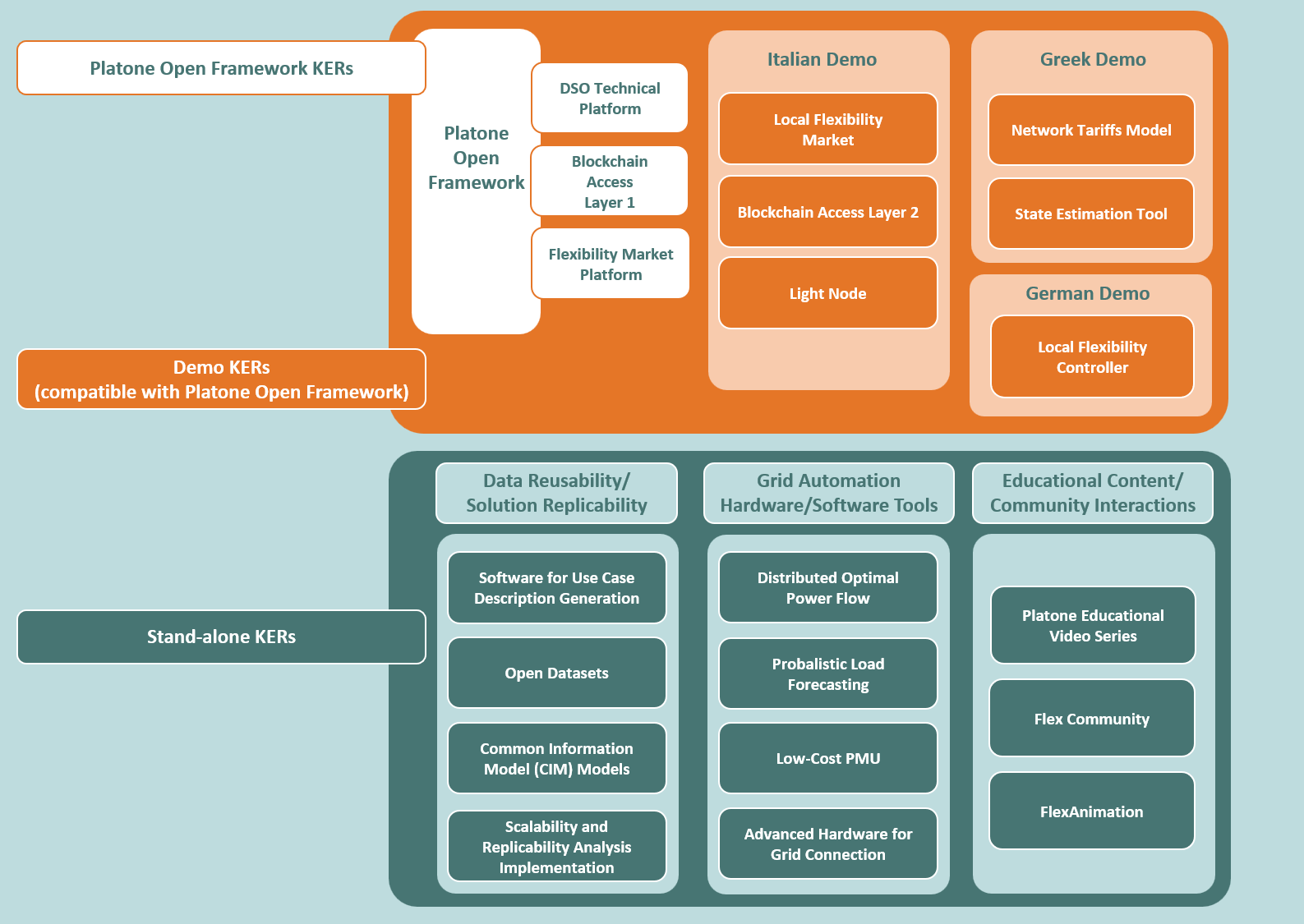The outcome of the extensive work conducted in different work packages led to certain Key Exploitable Results (KERs) which are the tangible outcomes, assets, or findings that hold significant value and can be leveraged for various purposes, such as commercialization, further research, or knowledge transfer. These results are the core achievements of the Platone project and can have a long-lasting impact.
These 21 KERs can be clustered in the following categories:
The proposed Platone open-source framework (POF) with three open-source components
- Open-source DSO Technical Platform for the deployment of distribution grid services and compatible with DSO existing proprietary and cloud-based platforms.
- Flexibility Market Platform which allows to implement a fair flexibility market, involving all the energy stakeholders including the customers.
- Blockchain Access Layer (1) which enables a secure energy data sharing and ensures the data ownership and governance.
Demo developments which evolve around POF with corresponding adaptations
Italian Demo
- Light Node which is installed at users' premises which gathers data from DSO smart meters on DERs' sites and receives and relays flexibility activation commands to the customers’ storage systems, smart home devices, etc.
- Local Flexibility Market through which DSOs can directly engage DERs to reduce grid congestions by matching DSO demands with aggregated bids of DERs and provided by service providers.
- Blockchain Access Layer (2) which acts as a trust-enhancing intermediary between DERs and the Local Flexibility Market by certifying real-time meter measurements.
Greek Demo
- Network Tariffs Model which analyzes historical data, generates representative day-types, creates tariff patterns for them, optimizes DER control, and facilitates real-time ancillary services.
- State Estimation Tool which acts upon both synchronized and conventional measurements and auxiliary functions to estimate the grid operating state.
German Demo
- Local Flexibility Controller which manages the balancing between local generation and consumption within renewable energy communities.
Developments independently from the Platone Open Framework
Data reusability and Solution Replicability
- Software for Use Case Description Generation web tool and repository for developing and storing the UC descriptions and data.
- Open Datasets representing demo specification and research data for validating Platone publications.
- IEC Common Information Model (CIM) Models related to demo field trial grid models.
- Scalability and Replicability Analysis Tools using the open source distributed power flow and scenario generator tools and CIM Platone grid models.
Grid Automation Hardware and Software tools
- Open-source modular Distributed Optimal Power Flow (OPF) solving OPF problems for AC, DC, and AC/DC systems.
- Deep-learning open-source Probabilistic Load Forecasting comprising recurrent neural network to predict consumption, PV, and wind time series.
- Low-Cost Phasor Measurement Unit (PMU) which enhances grid observability with high time-resolution and accuracy due to its frequent reporting.
- Advanced Hardware for Grid Connection enabling DC assets to connect to the power system via unified power and data connection.
Education Content and Community Interactions
- Platone Educational Video Series about the open source philosophy of Platone and the exemplary service deployment tutorials.
- FlexCommunity as a cross-border community for discussing flexibility-related topics and sharing knowledge.
- The Interactive FlexAnimation demonstrating the benefits of digitalization and flexibility in distribution grids.
The following diagram visualizes the clustering of the Platone KERs:
The Platone Key Exploitable Results
